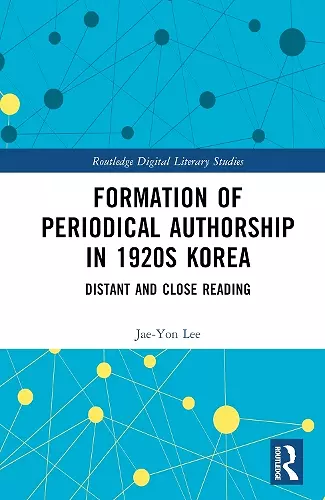Formation of Periodical Authorship in 1920s Korea
Distant and Close Reading
Format:Hardback
Publisher:Taylor & Francis Ltd
Published:6th Jun '23
Currently unavailable, and unfortunately no date known when it will be back

Formation of Periodical Authorship in 1920s Korea argues that Korean authors who entered the literary scene during modern literature’s formative years were the subject mediated by periodicals. However, it has been difficult to substantiate this statement because periodicals, including magazines, were open to different groups of writers; various social, literary, religious, and cultural discourses; and dissimilar genres. The multi-level interactions between terms, knowledge, and writing styles in circulation unfolded at a larger scale at some times, and at other times in such an ordinary manner that one can hardly identify and synthesize them to make any sense. Employing not only conventional close reading, but also modes of distant reading developing out of cultural analytics, Lee investigates the specific ways in which patterns of social, semantic, and stylistic interactions in Korea’s major magazines configured three kinds of authorship, namely the “narcissistic author,” the “prophetic critic,” and the “everyday reviewer.” He rereads artist stories, leftist social discourses, religious cosmology, and joint reviews through quantitative analyses and offers an engaging account on the importance of repetitions in creating literary originality. This book extends periodical studies through cultural analytics and opens up a new horizon for the next generation of literary scholars seeking innovative experiments in a digital age.
"This book represents a critical advance in the application of computational techniques to the study of non-English literatures. It is one of the first examples we have in English of how such techniques can potentially enhance our understanding of modern Korean literature. Lee offers a compelling model for how to adapt these techniques to the particularities of written Korean, but also for how to think with these techniques in conjunction with sociological, book historical, and hermeneutic approaches. As such, it stands as a major contribution to the fields of modern Korean literature and digital humanities and is sure to inspire future scholars who seek to work at the intersection of these fields."
--Hoyt Long, Professor of Japanese Literature, University of Chicago
"This book is an outstanding example of the application of distant reading and quantitative literary research to modern Korean literature of the 1920s. The 1920s in Korean literature were a unique period during which emerging writers, literary works, and literary media actively interacted to institutionalize modern Korean literature. The book aims to uncover the complex networks formed through these interactions and unravel hidden patterns that cannot be discerned when focusing solely on individual writers, works, and media. What is really impressive about this book is its demonstration that these patterns result from structural causality arising from the interactions among these actors. Not only does this book contribute to the renewal of the study of modern Korean literature, but it also opens up new possibilities for digital literary studies."
-- Yong-gyu Kim, Professor of English, Pusan National University
ISBN: 9781032383378
Dimensions: unknown
Weight: 453g
206 pages